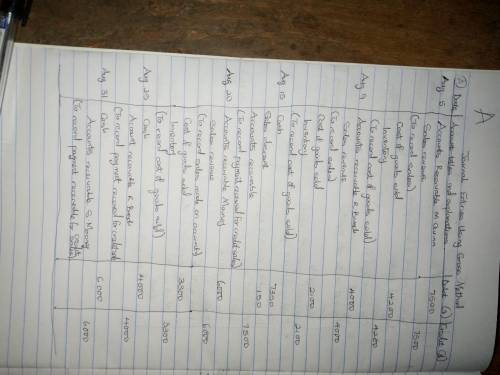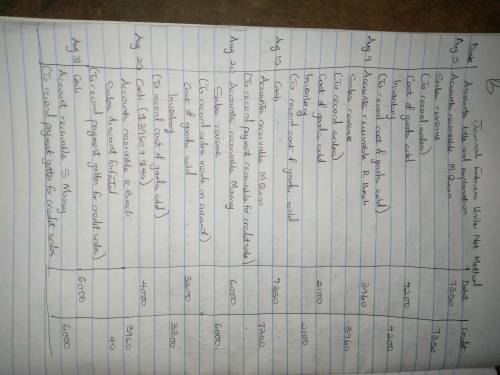
Business, 19.10.2020 19:01 janaes1217
Appendix 1: Gross and net methods for sales discounts
The following were selected from among the transactions completed by Strong Retail Group during August of the current year:
Aug. 5. Sold merchandise on account to M. Quinn, $7,500, terms 2/10, n/30. The
cost of the merchandise sold was $4,200.
9. Sold merchandise on account to R. Busch., $4,000, terms 1/10, n/30. The
cost of the merchandise sold was $2,100.
15. Received payment on account for the sale of August 5 less the discount.
20. Sold merchandise on account to S. Mooney, $6,000, terms n/eom. The
cost of the merchandise sold was $3,300.
25. Received payment on account for the sale of August 9. 31.Received
payment on account for the sale of August 20.
A. Journalize the August transactions using the gross method of recording sales discounts.
Aug. 5 Accounts Receivable-M. Quinn 7,500
Sales 7,500
Cost of Goods Sold 4,200
Inventory 4,200
Accounts Receivable-R. Busch 4,000
Sales 4,000
Cost of Goods Sold 2,100
B. Journalize the August transactions using the net method of recording sales discounts.

Answers: 1
Another question on Business

Business, 22.06.2019 15:00
Portia grant is an employee who is paid monthly. for the month of january of the current year, she earned a total of $8,388. the fica tax for social security is 6.2% of the first $118,500 earned each calendar year and the fica tax rate for medicare is 1.45% of all earnings. the futa tax rate of 0.6% and the suta tax rate of 5.4% are applied to the first $7,000 of an employee's pay. the amount of federal income tax withheld from her earnings was $1,391.77. what is the total amount of taxes withheld from the portia's earnings?
Answers: 2

Business, 22.06.2019 23:50
Melissa buys an iphone for $240 and gets consumer surplus of $160. a. what is her willingness to pay? b. if she had bought the iphone on sale for $180, what would her consumer surplus have been?
Answers: 3

Business, 23.06.2019 02:30
Suppose a starbucks tall latte cost $4.00 in the united states, 5.00 euros in the euro area and $2.50 australian dollars in australia. nominal exchange rates are .80 euros per dollar and 1.4 australian dollars per u.s. dollar. where does purchasing power parity hold? a. both the euro area and australia. b. neither the euro area or australia. c. the euro area but not australia. d. australia but not the euro area.
Answers: 1

Business, 23.06.2019 13:30
Everfi module 5 answers when planning for college, you should consider:
Answers: 3
You know the right answer?
Appendix 1: Gross and net methods for sales discounts
The following were selected from among the tr...
Questions


Biology, 25.11.2019 23:31


Mathematics, 25.11.2019 23:31






Physics, 25.11.2019 23:31

History, 25.11.2019 23:31


Health, 25.11.2019 23:31



Mathematics, 25.11.2019 23:31


Mathematics, 25.11.2019 23:31

Biology, 25.11.2019 23:31





